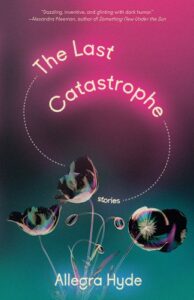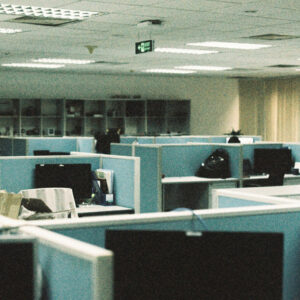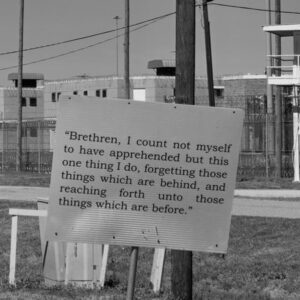
Exit Strategies: So How Are You Supposed to End a Story?
Allegra Hyde on Fiction’s Favorite Endings
“I hate endings. Just detest them,” said Sam Shepard in an interview with The Paris Review. “Beginnings are definitely the most exciting, middles are perplexing and endings are a disaster.”
Shepard is hardly alone in his aversion. For writers working in all mediums, ending a work can be the most challenging aspect of the writing process. Sure, there are outliers—Toni Morrison purportedly said: “I always know the ending; that’s where I start”—but for many of us, finding that conclusive beat is slippery, maddening, even disastrous.
As a writer and teacher of fiction, I can attest that few fiction workshops pass without the utterance of an ending-related critique. What’s more, those critiques tend to fall into one of two categories. The first: “This ending wasn’t satisfying.” And the second: “This ending wasn’t earned.” In other words: either a story’s ending was a letdown—given what the story seemed to promise—or the big swings taken by a story’s ending are not justified by what happens earlier.
So what’s a writer to do?
To start, maybe turn a critical eye upon those critiques themselves. Do we really want a story to satisfy? To earn? Recently, I sat on a panel with Dantiel W. Moniz, who pointed out that this language smacks of consumer capitalism. She’s more interested in pursuing endings with “resonance.” This feels like a better framework to me as well. Resonance is a way to talk about the music of a work of fiction, as well as the multitude of ways a piece might impact a reader.
My guess is that most writers (or perhaps the ones reading Lit Hub) are not working toward the goal of customer satisfaction. We’re trying to make art. We’re trying to disturb, or subvert, or illuminate, or render a literary experience so vibratingly transcendent that it resonates inside a reader long after the last page.
Okay, so what’s an anticapitalist writer to do?
I’ve been on a mission to find an answer, which is why I recently turned to the greatest source of wisdom and truth: Twitter. I wanted to get a sense of what made an ending especially compelling, so I asked the people of the internet to share their favorite endings in fiction. Responses poured in.
Middlemarch came up a number of times. So did a lot of Cormac McCarthy. On the ending of One Hundred Years of Solitude, one responder wrote: “It felt explosive the first time I read it, like I had been eaten up by the story myself.” This tracked with the intensely emotional way many people talked about their relationships to favorite endings. “I cried at the end,” people said; “I was wrecked”; “I had to lie down.” One person noted that a set of novel endings had pulled them out of a deep depression.
Powerful endings often elicit powerful emotions. Got it. But how can this (fairly obvious) observation help us as writers flailing around in the morass of an unfinished story or novel?
After reading through people’s favorite endings, I can say that a pattern did emerge. For all the complexity of pulling together the threads of a fictional narrative at the end of a piece, emotional impact was often created by an author’s manipulation of one particular craft element—an element so foundational that is often overlooked.
I’m talking about time.
All fiction operates along a narrative timeline. Whether or not the fictional work is written chronologically, there is an intrinsic sequence of events that exists in the universe of the story—and at the end of a piece, an author must decide where along that timeline they’d like a work to conclude. That decision has the potential to unlock a final beat of meaning and emotion for a reader. To put this another way: by being intentional about time at the end of a work, an author can create pattern, contrast, connection; they can generate resonance.
What form might such a temporal decision take? I’d argue that there are three major moves one can make at the end of a work of fiction:
• Flash back (the ending takes a retrospective turn)
• Stay in the present (the ending maintains linear chronological motion)
• Flash forward (the ending gestures to a future beyond the events depicted in the story)
Below, you’ll find a series of novel and story endings that have been categorized in these temporal terms. These examples demonstrate different “exit strategies” for creating resonance at the end of a work of fiction. I’ve tried to use well-loved works—both classic and contemporary—to minimize “spoilers.” But I’m talking about endings, so obviously proceed at your own risk.
*
Endings that flash backwards:
“Bullet in the Brain” by Tobias Wolff (back to the way beginning)
“The bullet is already in the brain; it won’t be outrun forever… But for now Anders can still make time. Time for the shadows to lengthen on the grass, time for the tethered dog to bark at the flying ball, time for the boy in right field to smack his sweat-blackened mitt and softly chant, They is, they is, they is.”
At the end of “Bullet in the Brain,” we know that Anders is going to die—but the story doesn’t end with his demise in a bank after getting on the nerves of a bank robber. Instead, we end in a memory. Not just any memory, either: a memory that gestures to the origins of Anders’s love of language. This shift to the past connects early events in Anders’s life to the very last: getting shot in the head for his semantic snickering. This ending also offers a gentler portrait of a person who is otherwise pretty unpleasant—and that contrast creates resonance.
Real Life by Brandon Taylor (back to the beginning)
“They finally appeared, his fated friends, four or five people, coming toward him on the sidewalk…Wallace was giddy, almost sick with excitement, to be in this place, among these people… Someone wanted to make a toast… To life, they said, imbuing those words with all their hope and their desires for the future. Their laughter rang through the night and through the trees, and on the shore they had left behind, people were eating dinner and laughing and crying and going about things as they always had and always would.”
The last chapter in Real Life takes readers to a scene that precedes everything that has already occurred in the novel—namely, Wallace’s miserable time studying biochemistry at a Midwestern university, where aggressions both micro and macro are unleashed upon him by the community and his supposed friends. As readers, we know what is going to happen to Wallace. This makes the ending note of Wallace’s innocent expectation all the more poignant.
The Swimmers by Julie Otsuka (back to the middle/end)
“One last memory. By the time you finish your third novel she has not spoken in more than a year… You give her a copy of your book and watch her slowly leaf through the pages… And when she gets to your face, she stares into your eyes with wonder. She does this loop again…And every time, when she gets to your face, she looks as if she is about to speak.”
As The Swimmers explicitly states, it is a novel that ends with a memory. A middle aged author visits her mother, Alice, who is nearing the end of her life in a care facility for dementia. At this point in the novel, we know that Alice will—has—died. The ending loops us back in time, offering a moment of grace, as well as a resonant sense of suspension that captures an important symbolic touchstone in the book: swimming laps in a pool, over and over.
“Lockwood” by Bryan Washington (back to the near-end)
“The morning before, Roberto’d shown me this crease on my palms. When you folded them a certain way, your hands looked like a star…Then he cupped his hands between us, asked if I’d found the milagro in mine.
I couldn’t see shit, just the outline of his shadow, but we squeezed our palms together and I called it amazing anyways.”
“Lockwood” follows the brief and clandestine relationship between the narrator and his next door neighbor Roberto. The story ends when Roberto’s struggling family must flee Houston, and after the narrator’s family does nothing to help. The story’s final move—to return to a moment of intimacy just before Roberto’s departure—offers a moment of togetherness for the two young men, as well as the sweetness of a white lie that balances the sadness of the situation.
Endings that end in the present:
Bridge by Evan S. Connell (the inescapable present)
“Having tried all four doors she began to understand that until she could attract someone’s attention she was trapped. She pressed the horn, but there was not a sound… Finally she took the keys from the ignition and began tapping on the window, and she called to anyone who might be listening, “Hello? Hello out there?”
But no one answered, unless it was the falling snow.”
In Mrs. Bridge, we follow the life and times of an upper-middle class housewife in the mid-twentieth century. She is trapped by conventions, manners, expectations. The novel’s ending, in which we leave Mrs. Bridge imprisoned in her old Lincoln in the garage, could come across as jarringly abrupt—but the palpable stuckness of the moment resonates as a summative symbol for the novel. Mrs. Bridge has been stuck her entire life; there’s a strange catharsis in having her realize her predicament, at least in a literal sense.
“The Husband Stitch” by Carmen Maria Machado (the decisive present)
“‘Do you want to untie the ribbon?’ I ask him. ‘After these many years, is that what you want of me?’
…My weight shifts, and with it, gravity seizes me. My husband’s face falls away, and then I see the ceiling, and the wall behind me. As my lopped head tips backward off my neck and rolls off the bed, I feel as lonely as I have ever been.”
Machado’s short story reimagines the urban legend “The Girl with the Green Ribbon” and, like in the original tale, the story ends with the narrator’s head falling off. Ending in the narrative present works, in part, because spooky urban legends are generally told chronologically—and sometimes end with a jump scare. In Machado’s story, the final moment is in some ways a small triumph—the narrator has proven why she could never remove her green ribbon—but mostly it’s a decapitative defeat, and this simultaneous import creates resonance.
“Fable” by Charles Yu (a present between the past and future)
“His lunch hour was over. The man got up to leave. On his way out the door, he said, See you next week, and the therapist said, Maybe. He turned to look at her.
She said, Let’s see where you go from here.
The man went down the hall, relieved himself, washed his hands, splashed water on his face. As he stepped back out into the hallway, that was when he saw it…In the carpet, the faintest outline.
A trail.
Where did it lead? Was it a way out? Or a way in?
And the man said to himself, All right, then, maybe she’s right. If this is where your story starts, then so be it.”
In a similar vein to “The Husband Stitch,” Yu’s “Fable” borrows from the form of fables and fairy tales by ending in the present. The protagonist has finished a therapy session in which he has used allegory to process his struggles as a father of a child with special needs. The story concludes with a glimpse of the protagonist discovering that new possibilities may await him. The present moment is thus a hinge between processing the past and facing the future. It’s not happy ever after, but it is a chance for greater happiness.
“Pioneer” by Lydia Conklin (an epiphanic present)
“Really, the end of the simulation was just the beginning. Coco knew that now. Not even Ms. Harper could help her. She pulled away and turned to face the yellow field, the milkweed, the curved path of cones. The sun was a low white hole in the sky. She would go on her journey now. She would set off.”
The ending of “Pioneer” makes its relationship to time conspicuous: the end is “just the beginning.” Like in “Fable,” the ending marks a shift between the protagonist’s past and future. Coco has endured an Oregon Trail reenactment, rejecting her gendered assignment despite the social costs (she chooses to be an ox, rather than a matriarch). There’s a sense of allegory here, as well as an epiphany about what the future holds. In this way, the narrative resonantly ends in a manner that feels both expansive and conclusive.
Endings that flash forward into the future:
The Handmaid’s Tale by Margaret Atwood (zooming forward with an epilogue)
“Being a partial transcript of the proceedings of the Twelfth Symposium on Gileadean Studies, held as part of the International Historical Association Convention, which took place at the University of Denay, Nunavit, on June 25, 2195… As all historians know, the past is a great darkness…Voices may reach us from it; but what they say to us is imbued with the obscurity of the matrix out of which they come… Are there any questions?”
Atwood ends her novel with a transcript from an academic conference taking place a few hundred years in the future from the rest of the novel. The transcript reveals that the story of Offred trying to survive in the patriarchal dystopia of Gilead is the product of confessional tapes discovered in a locker in Bangor, Maine. This future vantage serves to answer potential questions we might have about the trajectory of Gileadean society, as well as Offred’s fate. Whatever optimism this glimpse of the future might grant, however, is tempered by the chilling moral relativism of the male professor giving the talk. Thus, The Handmaid’s Tale’s move into the future offers both solace and an unsettling sense that patriarchal oppression might persists.
Leave the World Behind by Rumaan Alam (a potential future)
“She’d go back. She’d probably been missed, already, and felt a little guilty over not leaving a note…Maybe her parents would cry over what they didn’t know and what they did…Maybe Ruth would empty the dishwasher and G. H. would take out the garbage, and maybe the day would truly begin, and if the rest of it…was unclear, so be it. If they didn’t know how it would end—with night, with more terrible noise from the top of Olympus, with bombs, with disease, with blood, with happiness, with deer or something else watching them from the darkened woods—well, wasn’t that true of every day?”
Leave the World Behind keeps readers turning pages by dangling mysterious unknowns throughout the novel. By the end, many questions remain unanswered, so it seems fitting that the novel gestures mostly toward potentialities. Here, we are offered a vision of the possible future via both small domestic details and earth shattering events. Tragedy is likely to be an ongoing occurrence for the novel’s characters, but the positioning of this potential future leaves space for hope. The best and the worst of what’s to come is, after all, a “maybe.”
“Manzanos” by Kirstin Valdez Quade (a desired and anticipated future)
“If I could time my death, I would time it thus: exactly fifteen seconds after my grandfather. I would like to die in my sleep, but I must be certain I outlive him. I will lay my ear against his thin chest, listen to the silence beneath his lumped sternum, and then, when I am sure, it will be my turn…
In a moment my grandfather will pat me again, and his hand will stay there, resting on mine. I’ll look down, run a finger along the veins knotted and bruised under his thin brown skin. I wait for his touch. But for now we watch the horses separately, sitting as still as we know how.”
Technically, the last line of “Manzanos” returns to the present moment, but the main thrust of this ending is toward a desired and then an anticipated future. The story’s protagonist, Ofelia, wishes to die right after her grandfather. Odds are good that she won’t—and yet, by suggesting how that death might happen, the story captures her doomed conviction. Moreover, by following Ofelia’s death wish with a near-future vision of grandfatherly hand-patting, we end on a more likely future moment: one that is freighted with Ofelia’s awareness of her grandfather’s love.
“Burn” by Morgan Talty (a multiverse of futures)
“I kept going, wondering, Hair or pot first? Pot made the most sense…No. I’d grab Fellis’s hair from the swamp on my way home. With Fellis on his unmade bed, me on a torn beanbag in the corner, each of us with a tall boy and the pot smoke hazing gray the room, we’d keep poking and squeezing the hair, waiting for it to dry, waiting to burn it.”
“Burn” ends with a choice. Our narrator can first collect Fellis’s recently severed hair, or purchase pot. By describing the likely experience of pursuing each option, the story opens into the multiverse. The beauty of Talty’s ending is that even when the narrator ultimately elects to get the pot first, we know that he may not follow through. There are so many other possibilities—so many ways for things to go wrong—and this lends resonance to the seeming definitiveness of his choice.
*
How does one end an essay on endings?
Maybe, by taking one’s own advice. Thus, I offer you three endings to this essay using three different temporal moves. You can decide which one resonates the most.
Flashback
Before writing this essay, I spent a while thinking about what endings mean in the context of real life. I thought about the end of relationships, the end of my twenties, the end of living in one city and then another, the end of sixth grade, the end of my one-time favorite show Even Stevens, the end of liking bubblegum flavored ice cream. Life is a constant stream of endings—and so often we don’t realize their significance until it’s too late. Perhaps that’s why fiction so often looks backward, why characters lose themselves to memory, why a novel might end not with a vision of sailing into the future but rather in a floundering boat “borne back ceaselessly into the past.”
Staying in the present
So there you have it: my theory on endings. I’m not the first person to have one (According to Jeanette Winterson: “There are only three possible endings…revenge, tragedy or forgiveness. That’s it.”) and I likely won’t be the last. But I hope that you’ve found something useful in this essay. And if not, well, now we’re done (mic drop).
Flashforward
What will happen now, with this essay on endings finally finished? Well, the writer may stand up and stretch. She might pet her cat, then walk outside into a bright spring afternoon. Maybe she’ll see a patch of purple crocuses, a little stand of yellow daffodils newly blooming after a long damp winter under a gray midwestern sky. Maybe she’ll remember that nothing really ends, it just goes back to the beginning.
________________________

Allegra Hyde’s The Last Catastrophe is available now from Vintage.
Allegra Hyde
Allegra Hyde’s debut story collection, Of This New World, won the John Simmons Short Fiction Award through the Iowa Short Fiction Award Series. Her stories and essays have appeared in The Pushcart Prize, Best of the Net, The Best Small Fictions, and The Best American Travel Writing. Her debut novel, Eleutheria, published in March 2022. Originally from New Hampshire, she currently lives in Ohio and teaches at Oberlin College.












